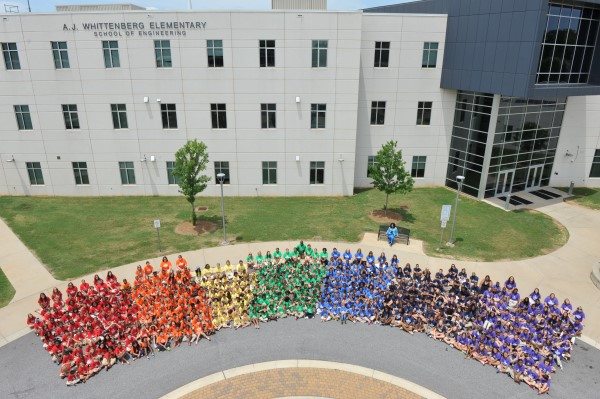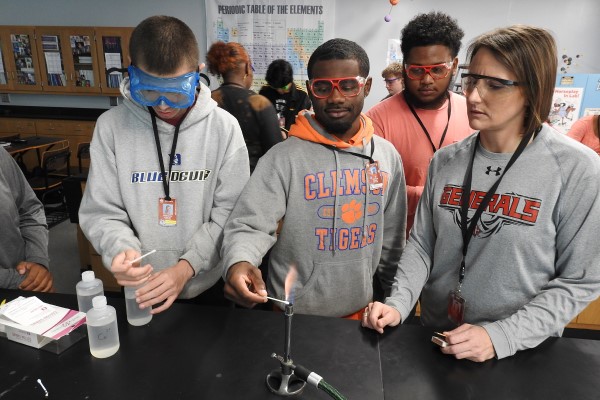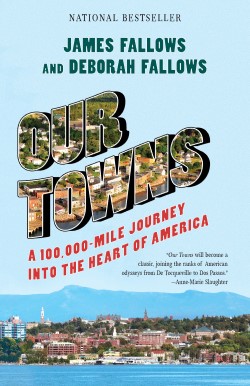How Schools Give Heart to Their Communities
August 01, 2019
What Deb Fallows learned about the essential place of public education during her cross-country visits
What central place do public schools command in the life and livelihood of towns and small cities across the country?
The answer appeared visibly obvious to Deborah Fallows during a four-year journey criss-crossing the country with her husband, James Fallows, the veteran journalist of The Atlantic, as they conducted up-close research for their 2018 book, Our Towns: A 100,000-Mile Journey into the Heart of America.
Deborah Fallows interacted with educators working in schools in no fewer than 14 communities that she studied during multi-day visits. A linguist, she handled most of the education visits on their cross-country travels, which included school stops stretching from Burlington, Vt., to Columbus, Miss., to Bend, Ore., and Winters, Calif. She interviewed teachers, principals, school board members and two of the three superintendents (Brian Davis, Holland, Mich.; Jay Badams, Erie, Pa.; and Bob Dooley, Ajo, Ariz.) who make appearances in the book. (Davis and Dooley remain today in their districts, while Badams is superintendent in Hanover, N.H., a school district straddling the state line with Vermont.)
School Administrator arranged for a veteran school leader and longtime AASA member, Brian Benzel, to interview Deb Fallows recently. In the Q&A that follows, she describes immigrant students and refugees altering the face of communities in some unlikely locations, schools paving innovative career pathways for those not heading off to higher education and the distinctive connections being made between K-12 schooling and public libraries and community colleges.
So many of the communities you visited — places in the Heartland such as Sioux Falls, S.D., where more than 10 percent of the students are English language learners — have experienced wholesale population change over the past generation by the influx of immigrants. You seem to have visited schools that were attentive to immigrant students’ needs and integrating them fairly well into the wider student population. What can we learn from those places?
FALLOWS: A number of the towns we visited have been generally welcoming refugees and immigrants for many decades. Some of the most successful towns focused on integrating not only the children but also the entire family into the schools and towns.
In Sioux Falls, one early-elementary school admits exclusively the newly arrived, non-English speaking children. Their whole-family program includes home visits, which goes to the core goal of integrating the children. What do the home visitors discover? The parents may not have gone to school themselves. Families may have faced long, dangerous and even traumatic journeys from their home countries. Some families speak only an uncommon dialect, which demands a serial translation from English to a country’s major language, and on to the dialect, and then back again in order to share information. Some children may have never used a public restroom or even a toilet. Others don’t know how to hold a pencil. Understanding the family situations and fashioning responses that will help one family at a time is intense work.

Older students bring more complicated issues. Some teenagers arrive with little or no schooling, especially girls. They are sorely out of sync with their age group. Cultural norms swing wildly with each new group of arrivals — dress codes, diets, expectations and traditions among religions and families. The list never ends.
We saw schools and towns that were alert to new challenges and would pivot quickly to respond. Students had no way to get home after late-day sports practices? Coaches and other parents stepped up. Fasting Muslim students spent lunch hours in the cafeteria watching their neighbors eat? Schools find them an alternative place to spend that time.
We saw challenges and efforts of school systems like these across the country. The intensity of the work requires support systems that extend beyond the schoolhouse doors, and it involves school leaders engaging with their peers in social services and business and religious communities.
The secrets of these towns were many, among them being attentive, open-minded and flexible.
Some rural communities survive now because of the productive roles being played by immigrants in their workforces, such as Dodge City, Kan. Take away those immigrants and those communities will very likely not survive. That message hasn’t resonated much lately, has it? What key factors did you discover about the role of schools in helping communities navigate this integration process? What pitfalls do you advise educational leaders to avoid?
FALLOWS: We found a general rule of thumb applied to attitudes toward immigrants: the farther a town was from settlements of immigrants, the more likely were its residents to be fearful and unwelcoming.
By contrast, a town with large immigrant populations could turn these attitudes on their heads.
Schools play a natural role here. They are the place where children and families meet each other, make friends, create understanding, and ultimately
value rather than shun differences. The children can be the best vehicles for a positive outlook. Not only are they in classrooms together all day long, but they may play or eat together or be partners outside the classroom as well. Parents can learn
from the children, and schools can provide opportunities. Schools have lots of natural tools at their fingertips: celebrations, food sharing, music, games, international days, dress-up, etc.
Educators in some of the places you spent time
have recognized that not all school graduates are destined for four-year universities. These educators are providing career and technical courses that have real-world application.
At Winters High School in central California, you found nearly half the students enrolled in agriculture-related coursework and the school had developed an agricultural site a few blocks from the high school where students were planning to develop an almond orchard. The 500-student school serves students from diverse socioeconomic backgrounds in a community that’s roughly half Latino. Other communities you visited with strong career pathways included St. Marys, Ga., and Fresno, Calif.
What conditions seemed to nurture distinctive partnerships between parents, business, local government and school? What advice from your investigation into this wide range of community successes would you share with school leaders for their current and future work?
FALLOWS: Schools are in a unique ground-zero position: they know the local opportunities ahead for their students; they are familiar with the family needs and cultures as well as the students’ promise; and they recognize the leadership and partnership potential in the community from government to business.
We have seen administrators and teachers who naturally lead and collaborate to imagine, guide and affect building creative and experimental programs in their schools. Within their schools, the changes may have often started at the top, but teachers were
quickly brought on board to train and build their own skills, to be trusted with making changes, and to wield new authority. We saw the teachers often as ambassadors for explaining their “new schools” to parents and the community, and
to being the most enthusiastic players in the ecology of change.

You identified community colleges as an aspect of America’s education landscape that seems to draw way too little attention. You found community colleges filling key roles today in Columbus, Miss., and Bend, Ore., among other places. Also, four-year schools and their graduate programs are noted for the energy they add to communities. Did you see elements of collaboration between K-12 schools and these postsecondary systems that would be worthy of sharing?
FALLOWS: You won’t be surprised to hear that we saw rich collaborations among the high schools and community colleges and universities. The older high school students could sometimes enroll in college-level courses. We also saw examples that are perhaps more surprising, where simple geographic proximity between, say, a middle school or high school and the college campus encouraged a busy two-way street. College faculty might visit and help teachers in elementary and secondary schools — as we heard about at Dr. Phinnize J. Fisher Middle School in Greenville, S.C. Or they offer a revolving door, inviting younger students to come look at their neighbors’ buildings and offerings. New ideas emerged just because people at different institutions were neighbors and got to know each other.
We also saw a lot of collaboration between schools and a multitude of businesses or organizations in a town. Cristo Rey High School, a Catholic school in Columbus, Ohio, offers a robust work-study partnership between students and local institutions. In Greenville, volunteers from local tech-heavy industry help design curriculum and teach some classes at the A.J. Whittenburg Elementary School of Engineering.
You and James interviewed superintendents in several communities and identified some who faced the especially steep challenge of addressing “economic and cultural headwinds” (Ajo, Ariz.), “a migration of students to private or religious schools” (Holland, Mich.), or the “currents of traditional structures” (Erie. Pa.). Did your observation of these forces lend a new appreciation for you for the role of the superintendent in leading a community’s public schools?
FALLOWS: Absolutely! We saw superintendents wearing any number of hats: financial analyst, diplomat, negotiator, politician, counselor and advisor, sociologist, consensus builder, educator, marketer and probably a lot more.
As you consolidated your observations and learning, what key elements of innovation did successful communities see in their schools?
FALLOWS: The success we saw started with leaders of innovation who knew the towns inside out. They understood a town’s assets and listened to the residents’ dreams and hopes for their children. Being true, relevant, and realistic to a community was essential. Maybe that meant classes on the business of farming and precision agriculture techniques in farming communities or options for medical certifications in towns with large healthcare institutions.
The school-by-school designs may have begun with visionaries. But moving those dreams to reality meant — in plain terms — marketing and selling to the community at all levels, from the most involved like principals and teachers to the less-personally engaged, like those without children or skeptical taxpayers.
You describe an amazing array of programs involving education sponsored by public libraries — from Charleston, W.Va., where laptop users hung out around the dumpster to get a Wi-Fi signal, to Ajo, Ariz., where the library was the source of access to e-mail, to Columbus, Ohio, where the library served as the first stop in searching for employment. What attributes of communities allowed schools, business and citizens to collaborate through their library systems?
FALLOWS: Public libraries today answer to the wants and needs of their communities. A year or two ago, we heard lots of comments from librarians of how their institution was “the best kept secret in town.” In our experience,
that perception is changing. More people recognize now what libraries can offer a community, from education of the youngest preschoolers, to accessibility to technology, to open and welcoming doors for civic and social engagement.

Libraries are open to everyone; they are democratic; they are trusted. Librarians are naturals to build relationships and connections when people come asking. Schools, for example, can ask libraries for help to support their teachers, to prepare their children for school, to help them with homework, to provide a safe place for them to spend time. And libraries will say yes.
Businesses will chip in, recognizing that not all these services come free, but they can bring a healthier more vibrant community when supported. Citizens report how much they value the services that libraries provide, and we have witnessed how they often respond at the ballot boxes with support for levies to keep libraries open or expand their services.
Facing devastating conditions, people in Eastport, Maine, showed a remarkable spirit. Especially captivating is the comment by Chris Gardner, director of the Eastport Port Authority: “My answer to everything is yes. Then we work out the details of what it would take.” How can America’s school leaders bottle this experience and determination into teaching and learning for our students? What did you observe that leaders need to better understand to leverage such powerful change?
FALLOWS: All I can suggest is that people travel, listen, communicate, ask and read — and look for possible links between the approaches that have worked for Eastport or some other community, and those that would make sense in one’s own hometown. Each community and school district is unique, but we’ve been impressed by the range of possibly shareable lessons, challenges and successes.
What else do you think important for school leaders to learn from your experience?
FALLOWS: An important lesson we learned is that leadership in a town starts anywhere — from a mayor to a philanthropist to a teacher. Indeed, we have seen a social studies teacher engage his students to learn about their town’s racial past and spark an entire community conversation about its history. We have seen a school superintendent turn a school system full of dropouts from traditional learning into an army of graduates who evangelize for nontraditional schools and refuse to let their younger siblings stray away. We have seen parents start charter schools that changed whole sections of urban deterioration into neighborhoods where young families are clamoring to live.
To me, that says that anyone can be a school leader, and schools can lead a community to change.
A Forthcoming Documentary


HBO is working with James and Deborah Fallows on a documentary relating to their book Our Towns: A 100,000-Mile Journey into the Heart of America. It is expected to air next summer.
In an announcement of the project that appeared in The Atlantic, the Fallows said they were conducting a new round of on-the-scene reporting from some of the places visited in their book. One of the subjects they intend to address is the reinvention of schools and libraries.
A goal of the HBO documentary, they said, is to explore “whether solutions being devised at the local level could percolate up to improve national-level politics.”
Advertisement
Advertisement
Advertisement
Advertisement


.png?sfvrsn=3d584f2d_3)
